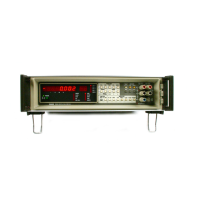850G
Series
The response
data
from the DMM will
be in 3-byte format, as shown below, for each voltage or current reading.
The first byte of this response contains sign
and
error bits,
an
implied
binary
point,
and an implied scale factor
of ten. Bytes 2 and 3 further define the reading. If the reading
is
negative, the sign bits
will equal
"1",
and all
three
bytes
must
be
two’s complemented
before conversion. If the error bit is equal to the complement of
the
sign bit, an error is defined.
BYTE
2
10 11
1111
1
Implied Binary Point
Error
Bit
—
Sign Bits
In this example,
the sign bits are
"1"
and the reading is negative. Since the
complement
of the sign bit does not
equal the error
bit
("1"),
no error is defined.
To convert the response in this example,
the
two’s complement must first be formed.
BYTE
3
1111
1111
BYTE
1
1111
0 111
0000 1000
+
0100 0000
+
0000
0001
-(0
5 + .015625 0 +
0
.000001)
=
0.515626
X
10
(the
implied scale factor)
Further conversion
to
calculate the true reading Rt necessitates multiplication of the A/D Converter
reading
(RAD)
by
the scale factor for the instrument’s range and function.
[R
t
=
Raq
X Scale Factor]
Ohms Readings In "I"
The procedure for measuring ohms
in
High
Speed
Reading
mode
is more complex. High Speed Ohms
readings differ from Fast Ohms
(Z1
)
readings; when using the
"!"
character, the
DMM will
not
compute
the true
reading. This conversion must be performed by the user. Up to 500 readings a
second are possible when using
High Speed
Ohms.
Refer to OPERATING NOTES, provided with Option
-05
and
-07
for High Speed Ohms
Reading
procedures.
j
8/16
Bit Toggle The
"/"
character is used to toggle between the 8-bit
v
J
and the 16-bit mode. When this character is used to
toggle from one mode to another, the
immmediate
and/or termination
character
must be
placed in the
least
significant
byte
(LSB) of the programming word.
2A-6

